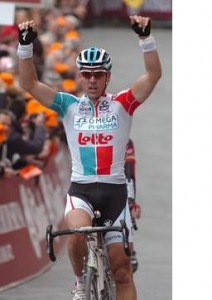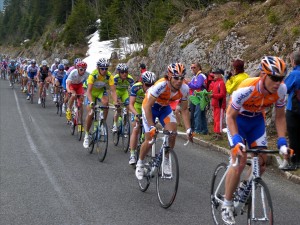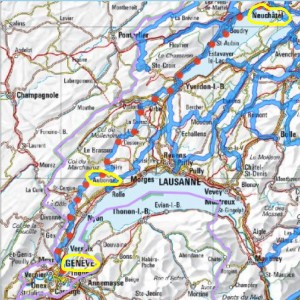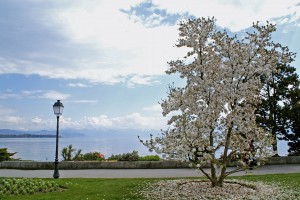The Race: Tour of Romandie
This week, April 26th-May 1st, is the Tour de Romandie. Romandie is the primarily French-speaking western part of Switzerland. The Tour de Romandie is different from the races we’ve been to so far, because it takes place over multiple days. Instead of taking place on a single day, the Tour de Romandie is 6 days long and consists of a prologue – a mini warm-up stage – and 5 longer stages. (Not all stage races are the same length. The Tour de France, for example, lasts nearly a month and consists of 21 stages). Each stage has a winner, but the overall winner is determined by who has the fastest time over all the stages – so it’s entirely possible for someone to win a stage race without winning an individual stage (which is to say, you can win the race without actually winning a race…). In addition to the overall title (also called GC for General Classification), there is also a Sprinter’s title up for grabs as well as a King of the Mountain title for the best climber. To keep track of who is in the lead after every stage, the leader in the GC wears the leader’s jersey for the next stage. (While traditionally yellow, the leader’s jersey can be any colour; for example in the Giro d’Italia, it’s pink). The leader for the sprint wears a green jersey, and the King of the Mountain wears white with red polka dots.
But enough about stage races in general. As noted above, the Tour de Romandie consists of a prologue (a 2.1 mile time trial that is held in Martigny), and 5 stages.

Elevation profile for the prologue.
The first stage is a 108 mile race from Martigny to Leysin:

Elevation Profile for Stage 1
The second stage is 107 miles of loops around Romont:

Elevation Profile for Stage 2
The third stage is 103.5 miles from Thierrens to Neuchatel:

Elevation profile for Stage 3.
The fourth stage is a 12.5 mile individual time trial from Aubonne to Signal-de-Bougy (called Contre la Montre – “Against the Watch”):

Elevation profile for Stage 4
And the final stage is 103 miles from Champagne to Geneva:

Elevation profile for Stage 5
The prologue at Martigny is the race’s southeastern-most point, and the stages head northwest up around Lake Neuchatel, before finishing at Geneva. You can see from the elevation profiles that with the exception of the time trial stages (the prologue and Stage 4), this race features some serious climbing.
A Brief Update on Liège-Bastogne-Liège
 Last week, we were in southern Belgium at Liège-Bastogne-Liège. The race was won by Philippe Gilbert from Team Omega Pharma-Lotto. He outsprinted the Andy and Frank Schleck (brothers who ride for Team Leopard Trek) to win his third race in twelve days, sweeping the Ardennes Classics. The Ardennes Classics are three races held in the region – The Amstel Gold, The Flèche Wallonne, and Liège-Bastogne-Liège.
Last week, we were in southern Belgium at Liège-Bastogne-Liège. The race was won by Philippe Gilbert from Team Omega Pharma-Lotto. He outsprinted the Andy and Frank Schleck (brothers who ride for Team Leopard Trek) to win his third race in twelve days, sweeping the Ardennes Classics. The Ardennes Classics are three races held in the region – The Amstel Gold, The Flèche Wallonne, and Liège-Bastogne-Liège.
Travelling with your Folding Bike
Like Belgium, Switzerland has a network of bike paths that make it a wonderful place to tour with a folding bike. If you’re looking to take in the race and then do some riding of your own, there are a number of loops you can ride around the cities where the stages are centered. You can also ride from one stage location to another along the paths, for example the Jurasudfuss Route can take you through the region where the final stages of the Tour of Romandie is held, from Neuchatel all the way down to Geneva. This is about an 80-mile ride, but if you didn’t want to do it all in one day, there are places to stop along the way (such as Aubonne, where the Stage 4 time trial takes place). And if you only wanted to ride part of the way, there is also public transportation accessible at various locations along the bike routes, so you could always hop on a bus or train with your folding bike.
While the Tour de Romandie includes a lot of climbing, there are definitely routes you can take that are flat to moderate in terms of terrain (especially around Lake Neuchatel and Lake Geneva). If you plan for flat routes, you might be most comfortable on the Crosstown or Boston 8. If, however, you’re planning to head a little further up into the hills (again, think foothills, not mountains – although the bike won’t be holding you back if you want to take on those steeper climbs) you’ll probably want to be riding the Navigator or the Fit. While most of the bike routes are paved, some still have unpaved sections – and if you’re more comfortable riding a mountain bike on dirt and gravel, you might want to take the Paratrooper or the Paratrooper Pro.
Taking in the Sites
Whether you’re interested in history, art and architecture, food and wine, or just beautiful scenery, there are so many different places to visit and things to see along the bike paths in western Switzerland, there’s truly something for everyone (castles/monasteries/museums/boat cruises/bike races). A folding bike is a great way to get around because riding is a great way to get a first-hand experience of the culture and countryside – and it’s a great way to work off some of the calories from some of that famous Swiss chocolate and beer. But if you find you need to get from point A to point B faster than your folding bike can take you, you can always take it with you on a bus or train, or even fold it up and take it with you in the back of a rental car.
Where have You Travelled?
Do you live in Switzerland or have you ever travelled there? Do you or did you do any cycling? Have you been able to check out the Tour de Romandie in person?




